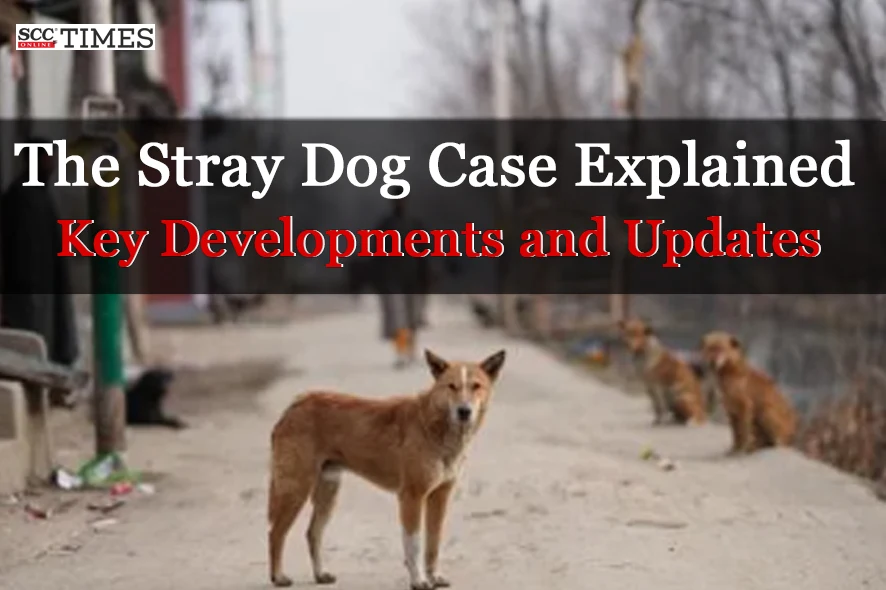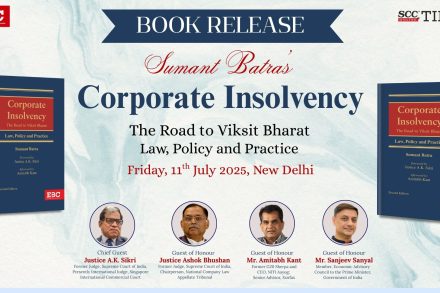Supreme Court: In a significant development, the suo motu case concerning stray dogs, in which directions were passed by a two-Judge bench on 11-08-2025, was transferred to a three-Judge bench. The previous Bench, comprising Justice JB Pardiwala and Justice R Mahadevan, had issued directions for the removal of stray dogs in the Delhi National Capital Region (‘NCR’) to shelter homes.
The matter was moved to the larger bench after several lawyers raised concerns before the Chief Justice of India, indicating that the directions issued on 11-08-2025 appeared to conflict with previous orders passed by other benches on the same issue.
As a result, a three-Judge bench comprising Vikram Nath, Sandeep Mehta, and Justice NV Anjaria , JJ. took up the case. After hearing the arguments, the Bench has reserved its order on the pleas seeking a stay on the directions issued on 11-8-2025 regarding the removal of stray dogs to shelters in the Delhi NCR.
How a Newspaper Headline Triggered Judicial Action
In its order dated 28 -07-2025 in City hounded by Strays, Kids Pay Price, In re, 2025 SCC OnLine SC 1670, the Court observed that the first and immediate step to be taken was to suo motu take cognizance of a deeply disturbing and alarming newspaper article published in the Delhi edition of the Times of India, titled “City Hounded By Strays, Kids Pay Price”. The newspaper article presented alarming facts and figures concerning the menace of stray dogs in the National Capital Region (NCR), highlighting a rapidly escalating public health and safety crisis. As per the report, hundreds of dog bite incidents were being reported daily in Delhi and its adjoining areas, many resulting in rabies infections, with young children, infants, and elderly citizens becoming victims of this life-threatening disease.
The Court expressed shock and deep concern upon learning that, as per the report, an average of 20,000 dog bite cases were being recorded across the country daily, with approximately 2,000 such cases occurring in Delhi alone each day.
It was brought to the attention of the Court that the Government of National Capital Territory (‘GNCT’) of Delhi had announced a scheme for the rehabilitation of stray dogs. However, the Court refrained from commenting on the efficacy of the said scheme and clarified that the priority must be the safety and protection of children and elderly citizens in the city.
The newspaper article cited a distressing incident involving a six-year-old girl, who suffered multiple dog bites, resulting in deep injuries to her leg, arm, and palm. Despite repeated complaints by local residents, the authorities had allegedly failed to take any action.
Another grievous incident, as reported, involved a four-year-old boy, who was attacked by a pack of stray dogs on 23-07-2025 in Alipur area of Narela, while returning from his Anganwadi school. The child sustained serious injuries to his face before bystanders intervened. The incident had caused panic among parents, many of whom were now afraid to allow their children to play outside.
In light of the above, the Court formally took suo motu cognizance of the situation reported in the newspaper article. The Registry was directed to register the matter as a Suo-Motu Writ Petition in public interest. Notice was issued to the Government of NCT of Delhi and the Municipal Corporation of Delhi, returnable on 11-08-2025.
City hounded by Strays, Kids Pay Price, In re, 2025 SCC OnLine SC 1688 : Actions and Directions issued on 11-08-2025
The Court noted that, according to data published on the website of the Press Information Bureau, the number of dog bite cases had been recorded for the years 2022, 2023, 2024, and January 2025. In the year 2024 alone, there were 37,15,713 reported dog bite incidents across the country. In Delhi, 25,201 cases were reported during the same period. In January 2025, Delhi recorded 3,196 dog bite cases. The data indicated a consistent rise in the number of dog bite incidents over the past three years. If the figures from January 2025 were any indication, the number of cases had increased by nearly 50%.
A. Court’s Observations dated 11-8-2025
The Court observed that the exercise it proposed to undertake was not intended to be performed in a casual manner. The pressing issue it had taken up was not the result of a momentary impulse. On the contrary, it was only after thorough deliberation and upon arriving at a firm conclusion regarding the systematic failure of the authorities concerned over the past two decades to address a matter central to public safety, that the Court resolved to take the matter into its own hands.
“We are conscious and sensitive of co-existence. The idea behind co-existence is not the existence of one’s life at the cost of the other.”
The Court stated that, in the present case, it was seeking to highlight the experiences of those who use the streets on a daily basis. The Court emphasised that streets ought not to be places of vulnerability. Among a multitude of concerns, the Court expressed particular pain in taking cognizance of the experiences of visually impaired persons, young children, the elderly, and individuals from humble backgrounds, many of whom are unable to afford even a day’s meal, let alone bear the burden of medical expenses arising from dog bite incidents. The Court noted that visually impaired individuals are at heightened risk, as their primary mobility aid—the cane, is often perceived as a threat by dogs.
Young children, too, are especially susceptible to dog bites, causing parents considerable anxiety and often deterring them from allowing their children to navigate public streets independently.
The Court found the plight of those compelled to sleep on the streets particularly distressing. Such individuals often lack not only awareness of the consequences of dog bites but also access to any precautionary or post-exposure treatment. The Court underscored the urgent need to address these concerns in the interest of public health and human dignity.
“It is often said that “no person is above the law”, however of equal significance is the flip side of that maxim; “no person is below the law” either”
The Court remarked that the protection, dignity, and security guaranteed by the law were not privileges to be conferred at the discretion of those in authority; rather, they were rights inherently vested in every individual, irrespective of their social status, circumstances, or means.
The Court emphasised that the true measure of a legal order lies not merely in how stringently it restrains those in positions of power, but in how faithfully and effectively it safeguards those living at the margins of society.
In light of the concerns raised, the Court urged all individuals to adopt and provide shelter to dogs within their homes. However, the Court clarified that it did not subscribe to the virtue signaling often displayed by those professing love and concern for animals.
The Court stated that its empathy extended equally to all. It strongly condemned those who, under the guise of compassion for the voiceless, sought only the comfort of self-congratulation. . The Court emphasised that its actions were not driven by personal sentiment, but by its constitutional responsibility to uphold the public interest.
“As the sentinel on the qui vive—a vigilant guardian of rights, the Judiciary bore the solemn responsibility to demonstrate the courage and strength required to remind the public of truths that they might find uncomfortable or may prefer not to acknowledge.”
The Court acknowledged the genuine love and care that many stakeholders in the public had for stray dogs. It urged them to come forward and actively participate in this important initiative. The Court emphasized the need for individuals to responsibly contribute to the care and upkeep of stray dogs at shelters and pounds. It also called on the public to volunteer their time and resources to ensure the proper functioning of these shelters and to assist the concerned authorities in this regard.
B. Key Directions issued by Supreme Court on 11-08-2025
(I) The Government of National Capital Territory of Delhi (‘NCT’), the Municipal Corporation of Delhi (‘MCD’), the New Delhi Municipal Council (‘NDMC’), and the authorities of NOIDA, Ghaziabad, Gurugram, and Faridabad were directed to initiate the process of picking up stray dogs from all localities, particularly from vulnerable and peripheral areas. The authorities were granted discretion to determine the mode and structure of implementation, including the creation of a dedicated task force if necessary. This was to be the foremost step toward making the entire NCR region free from stray dogs.
(II) The Court made it unequivocally clear that there should be no delay or compromise in the execution of this directive. It further cautioned that if any individual or organization attempted to obstruct the lawful rounding-up of stray dogs and such obstruction was reported, the Court would take the strictest action against the erring parties.
(III) The above directions were issued solely in the interest of public safety, with particular concern for infants, young children, and the elderly, to ensure that they were not exposed to the risk of potentially fatal dog bites leading to rabies.
(IV) The aforesaid authorities were directed to establish dog shelters/pounds throughout the NCR and report the establishment of such infrastructure within eight weeks from the date of the order.
(V) The shelters/pounds were required to be adequately staffed to ensure the sterilization, deworming, immunization, and general welfare of the impounded dogs. Strict monitoring via CCTV was mandated to prevent the release or unauthorized removal of any dogs from the shelters.
(VI) While recognizing the welfare concerns for the stray dogs, the Court directed that no mistreatment or cruelty should be inflicted. It was further directed that there should be no overcrowding, and that food and medical care must be regularly and adequately provided. At least two responsible personnel were to be present at each shelter at all times, with proper duty rosters maintained.
(VII) Special provisions were to be made for weak and vulnerable dogs, and these were to be housed separately wherever possible.
(VIII) The authorities were permitted to consider the feasibility of implementing an adoption scheme for stray dogs, but only in accordance with the Standard Protocol for Adoption of Community Animals dated 17-05-2022 issued by the Animal Welfare Board of India. Any adoption process was not to result in re-release of the dog(s) onto the streets. Strict action was to be taken against any infraction.
(IX) As a progressive exercise, authorities were directed to begin with the creation of shelters for at least 5,000 dogs within six to eight weeks.
(X) Daily records of captured stray dogs and the number of dogs housed in the shelters/pounds were to be meticulously maintained and presented before the Court on the next date of hearing. It was reiterated that under no circumstances should any dog be released back into public spaces.
(XI) Measures were to be adopted to mark/identify each impounded dog to ensure traceability and prevent re-release.
(XII) All authorities concerned were directed to create a helpline within one week of the order, for reporting dog bite cases. The relevant dog(s) were to be captured within four hours of any complaint. Any resistance to this direction was to be treated seriously and dealt with under contempt jurisdiction.
(XIII) All captured stray dogs were to be sterilized, dewormed, and immunized as per the Animal Birth Control Rules, 2023, and were not to be released under any circumstances.
(XIV) Upon receipt of any dog bite complaint, the authorities were also to inform medical authorities for immediate treatment of the victim.
(XV) A detailed report was to be submitted to the Court on the next hearing date.
(XVI) Recognizing the shortage of genuine rabies vaccines, the Government of NCT of Delhi was specifically directed to provide public information regarding the availability and location of such vaccines, maintain monthly data on stock levels, and the number of patients treated.
During the course of the hearing, the Court was apprised of the pendency of a writ petition, being titled Parthima Devi v. Municipal Corporation of Delhi1, before the Delhi High Court. It was brought to the attention of the Court that in the said matter, a similar initiative involving the construction of a dog shelter/pound by the Municipal Corporation had been stayed by the High Court.
Considering the overlapping and similar nature of the issues involved and the present suo motu proceedings, the Court was of the considered view that it would be appropriate for the said writ petition to be heard along with the present matter. Accordingly, the Court directed the Delhi High Court to transfer the writ petition, titled Parthima Devi v. Municipal Corporation of Delhi, along with the entire case record, to this Court at the earliest.
The Court further directed that the present matter be listed again after a period of four weeks, along with a comprehensive Status Report and all pending intervention application(s), and be placed on top of the Board on the said date.
Special Bench in Session: What Transpired on 14-08- 2025
The three-Judge Bench reserved its order on the pleas seeking a stay on the directions earlier issued by the two-judge bench concerning the removal of stray dogs to shelter homes in the Delhi NCR.
1. W.P. (C) No. 67 of 2023







